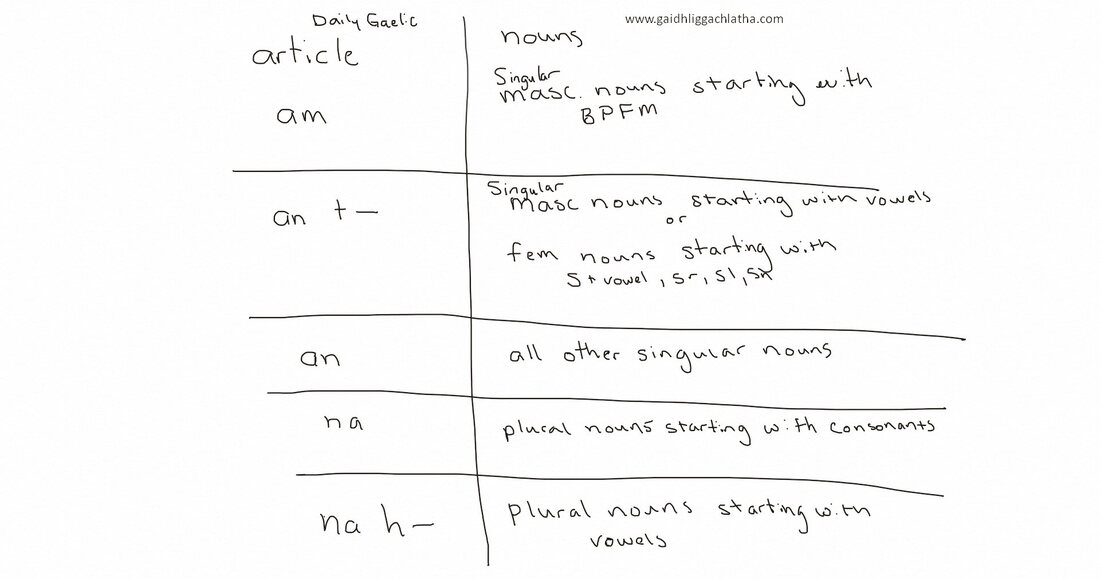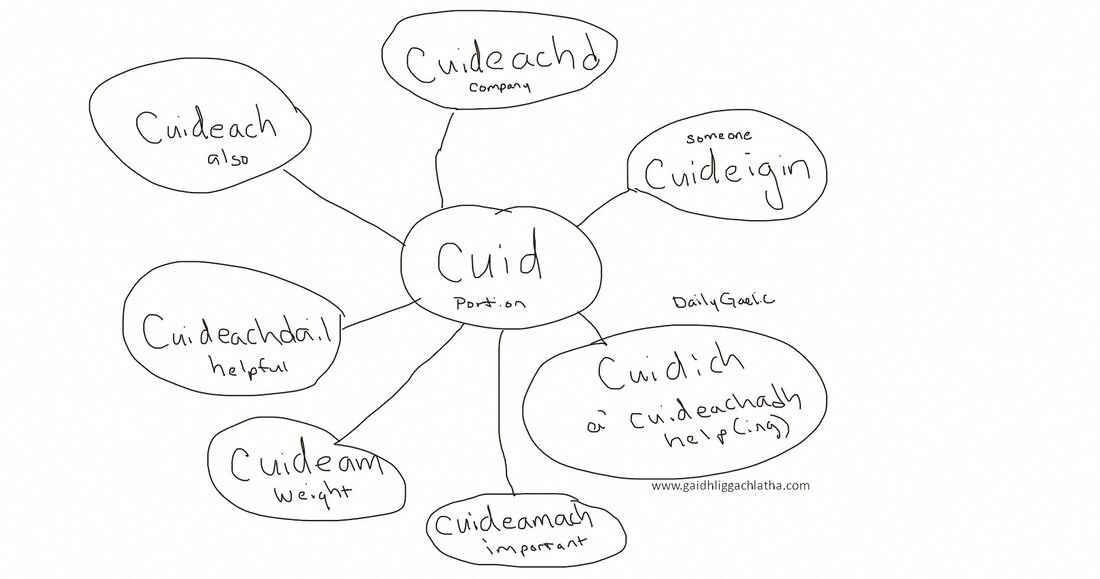here are some fun things to look at and think aboutThere is a lot of crossover in the sets of Gaelic vocabulary for body parts and landscapes/place names There are a few different ways of looking at definite articles in Gaelic (nominative) chart: flow chart all the choices How learning one word can help you learn lots of other words
0 Comments
an seòmar-cadail (m) = la chamber à coucher
an leabaidh (f) = le lit a’ chluasag (f) = l’oreiller an lampa (m) = la lampe am preas-aodaich (m) = l’armoire (pour les vêtements) am bòrd-leapa (m) = la table de nuit cadail !, a’ cadal = dormir anns an t-seòmar-cadail = dans la chambre à coucher Tha mi anns an t-seòmar-cadail = je suis dans la chambre à coucher Tha mi a’ dol dhan t-seòmar-cadail = je vais dans la chambre à coucher oidhche mhath ! = bonne nuit !
An taigh (m) = la maison
Am flat (m) = l’appartement Dachaigh (f) = chez-soi, foyer Am mullach (m) = le toit An làr (m) = le sol An doras (m) = la porte An uinneag (f) = la fenêtre An seòmar (m) = la pièce, la chambre An àirneis (f) = le mobilier An staidhre (f) = les escaliers Tha mi a’ fuireach ann an taigh = j’habite dans une maison Tha mi a’ fuireach ann am flat = j’habite dans un appartement Tha mi a’ dol dhachaigh = je vais à la maison / chez moi Seo mo dhachaigh = voici mon chez-moi Thig a-steach ! = Entre ! Thigibh a-steach ! = Entrez !
Here are some helpful words around the house:
am bòrd. the table. This word is masculine so if you want to use an adjective it will look like this: am bòrd gorm. The blue table. a' chathair. the chair This word is feminine so if you want to use an adjective it will look like this: a' chathair phinc. The pink chair. an doras. the door. This word is masculine so if you want to use an adjective it will look like this: An doras geal. the white door. an leabaidh. This word is feminine so if you want to use an adjective it will look like this: an leabaidh bhog. the soft bed. an uinneag. the window This word is feminine so if you want to use an adjective it will look like this: an uinneag bheag. the small window.
Am foghar = l’automne
An geamhradh = l’hiver An t-earrach = le printemps An samhradh = l’été as t-fhoghar = en automne sa gheamhradh = en hiver as t-earrach = au printemps as t-samhradh = en été
an t-sìde / an aimsir = le temps (qu’il fait)
Ciamar a tha an t-sìde an-diugh ? = Quel temps fait-il aujourd’hui? Tha i brèagha = il fait beau Tha i blàth = il fait chaud Tha i fuar = il fait froid Tha i fliuch = c’est pluvieux/humide Tha i sgòthach = c’est nuageux Tha i ceòthach = c’est brumeux Tha an t-uisge ann = il pleut Tha e a’ cur an t-sneachda = il neige
Tha mi… / Chan eil mi... Je suis... / Je ne suis pas...
sgìth fatigué(e) toilichte content(e) brònach triste feargach en colère snog gentil(le) èibhinn drôle leisg paresseux/paresseuse socharach timide trang occupé(e) deiseil prêt(e) tinn malade Et pour mettre un peu de nuance… beagan = un peu uabhasach = terriblement, extrêmement Tha mi deiseil – Je suis prêt(e) Chan eil mi tinn – Je ne suis pas malade Tha mi uabhasach brònach – Je suis terriblement triste Tha mi uabhasach toilichte – Je suis extrêmement content(e) Tha mi beagan sgìth – Je suis un peu fatigué(e) Chan eil mi uabhasach trang – Je ne suis pas extrêmement occupé(e) About the teachersMarine |
Details
AuthorsCaroline has been involved with Gaelic for more than 18 years. She has degrees in Celtic Studies and Gaelic Medium Teaching. Archives
March 2021
Categories
All
|
Proudly powered by Weebly
















 RSS Feed
RSS Feed